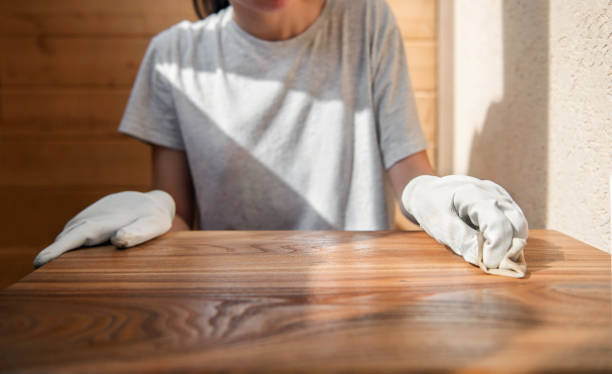Wood surfaces bring warmth, character, and natural beauty to any home. From hardwood floors and oak staircases to wooden countertops and furniture, these materials elevate interiors with timeless charm. But wood is also a living, breathing material that requires proper care. Many homeowners, often with the best intentions, make mistakes that shorten the life of their wood surfaces and diminish their appearance. Avoiding these errors can help preserve your investment and maintain the elegance of your living spaces.
Using Too Much Water for Cleaning
One of the most common mistakes is overusing water while cleaning wood. Unlike tile or vinyl, wood is porous. Excess moisture seeps into the grain, causing swelling, warping, or even rot over time.
- Mopping with a soaking wet mop or leaving standing water on wood surfaces damages the finish and the underlying material.
- Even steam mops can introduce too much heat and water, which compromise sealants.
The solution: Always clean wood floors and furniture with a damp — not wet — cloth or mop. Use specialized wood cleaners that are pH-balanced and safe for the finish. Wipe spills immediately to prevent stains and damage.
Using Harsh Chemicals
Bleach, ammonia, and abrasive cleaners may be effective on other surfaces, but they wreak havoc on wood. These chemicals strip protective finishes, dull the natural sheen, and can leave permanent discoloration.
Instead, use products designed specifically for wood care. For everyday maintenance, a simple mixture of mild soap and water on a lightly dampened cloth is safe. Periodically, apply conditioning products to nourish the wood and protect it from drying out.
Ignoring Humidity Levels
Wood naturally expands and contracts with changes in humidity. Ignoring this fact often leads to cracking, cupping, or gapping in hardwood floors and furniture.
- In overly dry conditions, wood shrinks and cracks.
- In humid environments, it swells, causing buckling or sticking doors and drawers.
Homeowners can prevent these issues by using humidifiers in winter and dehumidifiers in summer. Aim to maintain indoor humidity levels between 40% and 60% to keep wood stable.
Skipping Regular Maintenance
Many people assume that once wood floors or furniture are installed, they will last forever with minimal care. Unfortunately, neglecting maintenance accelerates wear and tear.
- Failing to dust regularly allows dirt and grit to act like sandpaper, scratching surfaces.
- Not resealing floors periodically leaves them vulnerable to water and stains.
- Ignoring professional refinishing leads to dull, uneven surfaces over time.
Best practice: Establish a routine care schedule. Sweep or vacuum with a soft-bristle attachment weekly, reseal floors every few years, and hire professionals for refinishing when the surface looks tired.
Dragging Heavy Furniture
Moving furniture without proper protection is one of the fastest ways to damage wood floors. Chairs, couches, or tables dragged across hardwood can leave deep scratches and dents.
To avoid this:
- Lift furniture instead of dragging it.
- Use felt pads under chair and table legs.
- Place rugs or mats in high-traffic areas to minimize wear.
Overlooking Sunlight Damage
Sunlight streaming through windows may look beautiful, but prolonged UV exposure can fade wood finishes and discolor surfaces. Many homeowners don’t realize this until uneven patches appear on floors or furniture.
Simple solutions include:
- Rotating rugs and furniture regularly to balance light exposure.
- Installing curtains, blinds, or UV-protective films on windows.
- Choosing finishes with UV protection when refinishing.
Applying the Wrong Products
Not all wood finishes are the same, and applying the wrong product can do more harm than good. For example, using oil-based polish on polyurethane-coated floors leaves a greasy residue, attracting dust and dirt.
Before applying any product, identify your surface’s finish: oil, wax, polyurethane, or lacquer. Then choose cleaners, polishes, and conditioners that are compatible. When in doubt, test a small area first or consult a professional.
Forgetting About Protective Measures
Another mistake is failing to think ahead about how daily activities affect wood. Pets with untrimmed nails, children’s toys, or high heels can all leave permanent marks.
Adding protective measures like area rugs, entryway mats, or clear furniture pads significantly extends the life of wood surfaces. These small investments prevent expensive repairs later.
Not Seeking Professional Help When Needed
DIY care works for basic cleaning, but larger issues like deep scratches, dullness, or warped boards require expertise. Attempting to fix these problems with household tools or YouTube tutorials often worsens the damage.
Professional wood care specialists use advanced sanding, restoration, and sealing techniques that bring surfaces back to life. Companies like FloorOx specialize in floor sanding, restoration, and repair, helping homeowners protect their wood investments for decades.
Final Thoughts
Caring for wood surfaces doesn’t have to be complicated, but it does require attention and the right approach. Avoiding excessive water, harsh chemicals, and neglect goes a long way toward preserving wood’s natural beauty. Paying attention to humidity, sunlight, and protective measures ensures long-term durability. And when deeper maintenance is needed, relying on professionals guarantees safe, high-quality results.
Wood is more than just a material — it’s a living feature of your home. Treating it with care not only protects its appearance but also ensures it continues adding warmth and value to your space for years to come.

